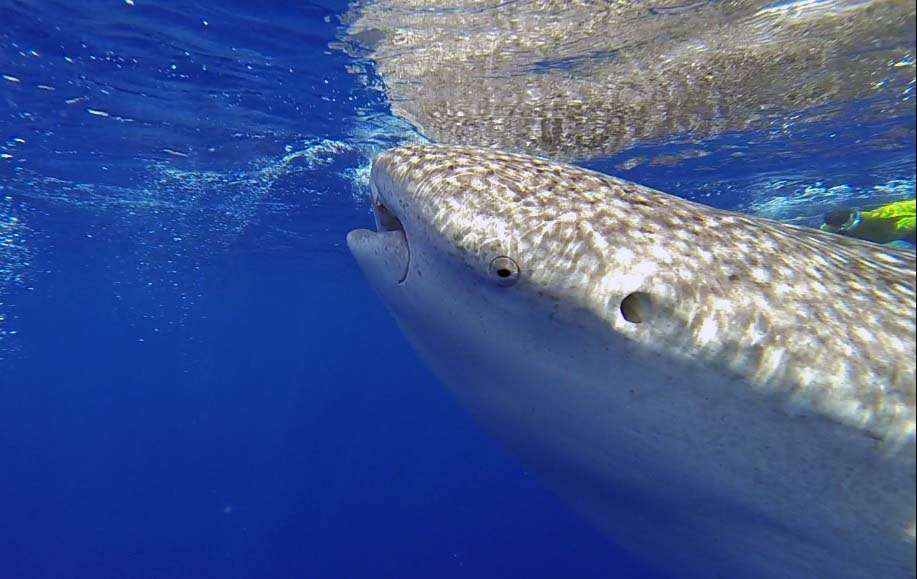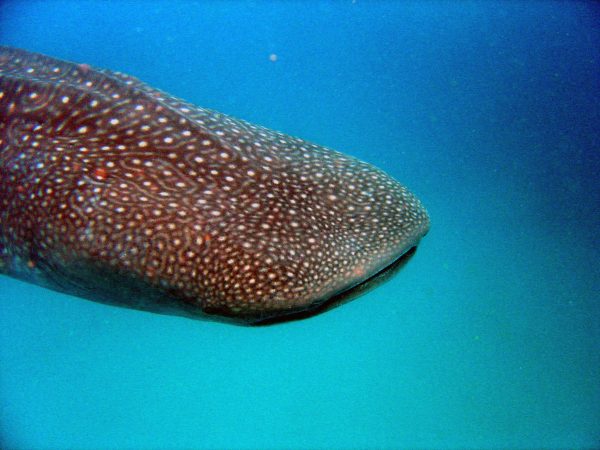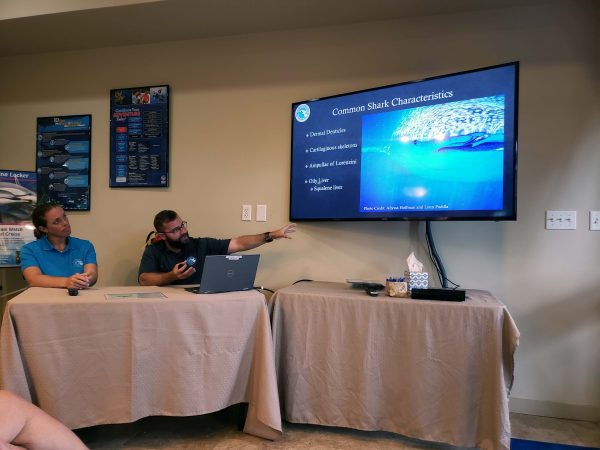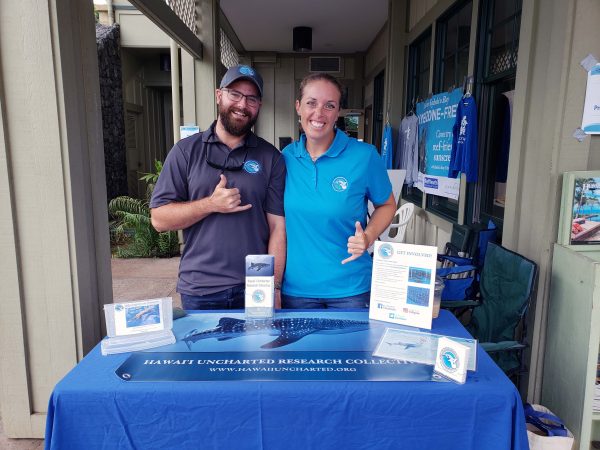Jumping Into the Deep End with Whale Sharks in Hawaii

A whale shark. (Credit: Maria Harvey, via communication with HURC.)
Over the past few years, people in Hawaiian waters have been spotting whale sharks more and more often—and researchers are wondering why. Now, the dedicated team of researchers from the Hawaii Uncharted Research Collective (HURC) is working to find out with the Whale Shark Initiative. Chief Technical Scientist Travis Marcoux and Chief Research Scientist Stacia Goecke of HURC spoke with EM about the inspiration for the whale shark research program and its connection to HURC.
“Our Director, Maria Harvey, and Stacia worked on the water in Kona together for many years, and occasionally tour boat operators would report sightings of whale sharks,” explains Dr. Marcoux. “Maria and Stacia knew a lot of tour boat operators and recreational ocean users, and whenever there was a report of a whale shark, many would exclaim how ‘cool’ and ‘rare’ the opportunity was, but they started realizing that, cumulatively, people were actually sighting these animals with some regularity (it was rare for the individual, but not altogether rare for the community).”
Several years later, Maria was working captaining a sailboat from California into Mexico and met Dr. Dení Ramírez Macías (founder and principal research scientist of Whale Shark Mexico) while observing an area where whale sharks aggregate.
“Maria mentioned sightings in Hawaii and how we were curious about how often they were actually being sighted,” continue Dr. Marcoux and Dr. Goecke. “Dr. Dení Ramírez Macías said that very little is known about whale sharks in Hawaii, and since there have been studies showing individuals traveling across the Pacific, she encouraged Maria to form a non-profit and study whale sharks here.”
Maria then approached Stacia and Travis and asked if they would like to help start a non-profit marine science organization, inspired to pursue under-studied and lesser-known marine science topics important to the Hawaiian Islands.
The overall aims of the program include bringing the human community together to protect the whale shark.

Research scientist Maria Harvey. (Credit: HURC, via communication with HURC.)
“We pair citizen science and education with scientific research and technology to learn more about this relatively unknown species in Hawaiian waters,” Drs. Marcoux and Goecke add.
This way, the team’s research efforts help increase knowledge of and awareness about whale sharks and produce scientific evidence that can inform conservation efforts. According to the HURC team, the organization will be studying animal behavior, ecology, population dynamics, and human impacts.
“Our findings will be published in peer-reviewed scientific journals with the goal of implementing and supporting global conservation efforts of whale sharks and their environment,” comment Drs. Marcoux and Goecke. “We will also be sharing our findings with the general public through formal educational presentations and outreach events.”
Why whale sharks, now?
It’s important to get more data about whale sharks in US waters now, for a variety of reasons. The HURC team explains that there is very little known about whale sharks in Hawaiian waters or other places in the US. They are listed as a species that travels through Hawaiian waters and are occasionally seen there migrating, but much of what has been observed about them has been anecdotal.
“There are many organizations worldwide committed to studying whale sharks, including our proud partners, Whale Shark Mexico, and Wildbook, which holds the international database of individual whale sharks,” remark the HURC researchers. “Whale sharks are known to travel long distances, even across ocean basins.”
A recent paper by Guzman et al., 2018 tracked a tagged individual from Panama, south of Hawaii Island all the way to the Marianas Trench over the course of 841 days: the longest recorded track for the species so far.

Whale shark near Manta reef, Guinjata Bay. (Credit: User: (WT-shared) Pbsouthwood at wts wikivoyage [CC BY-SA 3.0 (https://creativecommons.org/licenses/by-sa/3.0)], from Wikimedia Commons.)
Although they are not officially listed as an endangered species in the US under the Endangered Species Act, globally, whale sharks have been listed on the IUCN Redlist as endangered since 2016, when they were upgraded from “vulnerable” status. This is because the global population of these creatures has declined by more than 50 percent, according to estimates, since 1975.
“Peaking in the 1990s and early 2000s, there was a lot of pressure on the species due to directed fishing and accidental catch, or by-catch,” explain the researchers. “Most places around the world have since created laws that protect whale sharks from directed fishing and minimize by-catch with new technologies and better awareness.”
Other pressures include vessel strikes. Because whale sharks spend much of their time in the shallow depths of the ocean, swimming relatively slowly without necessarily breaking the surface, it’s painfully easy for rapidly-moving vessels to strike them. This is not the only threat we humans pose to these large yet peaceful creatures.
“With many places shifting from fishing to eco-tourism, they may also potentially be injured or disturbed by human interaction,” remark the researchers. “Many places where swimming with whale sharks is popular have since adopted voluntary guidelines for keeping humans and whale sharks safe. They are gentle giants and not aggressive typically in their nature, but they also can attain sizes up to that of a school bus, so they deserve a respectful distance.”
The HURC team has created downloadable guides with a suggested code of conduct for interacting with whale sharks based on accepted guidelines in other locations worldwide. These are available on the organization’s website.
“Luckily many pressures on their global population have been reduced over the past two decades, but unfortunately, there is so little known about whale sharks, their reproductive biology and populations on the global scale that it is currently difficult to assess potential steps towards recovery,” add Drs. Marcoux and Goecke.
Research questions and whale sharks
There have been reported sightings of whale sharks in Hawaiian waters for many decades. The HURC team has anecdotal sightings shared from as early as the 1960s and photographic sighting submissions from as early as 1991 in their database. However, the number of sightings has increased.

The HURC team presenting their work. (Credit: HURC, via communication with HURC)
“Since we went public with our non-profit in October of 2017, we have seen a much larger number of whale sharks reported than we anticipated based on commonly shared information, such as rumors and boat tales,” remark the scientists. “This is likely not due to an increase frequency in sightings but more to a greater community awareness of the potential to see a whale shark, which results in more eyes carefully watching the water.”
The team began to see higher numbers starting in 2014 compared to historical sightings reported.
“This is likely due to the increased availability of reliable and affordable underwater digital cameras,” comment the scientists. “Currently we have over 120 verified, documented sightings from 1991 to 2018—with over half of those reported from 2017 (when we started our research) and 2018. It is likely that whale sharks have always passed through Hawaii, but it was so rare for an individual to see that they weren’t reported.”
Because whale shark sightings in Hawaii are irregular and unpredictable, these animals are difficult to study by traditional means. This is why the work the HURC team does is so important.
“We are able to gather the shared, community experience to compile information about a poorly known species in an area they haven’t been studied previously,” comment Drs. Marcoux and Goecke.
Whether the animals were always present but undetected, or whether their range is shifting due to climate change or other forces, remains unclear for now.
“As far as Hawaii is concerned, it is too early to know for sure if their range is shifting or they are showing up in Hawaii with increased frequency; it isn’t possible to answer those questions without having an idea of baseline distributions or sighting data,” explain the HURC researchers. “This is another reason why the work we’re doing is so important. Currently, we are recording any and all sightings of whale sharks in Hawaiian waters shared with us by the community and entering them into a database.”
Another interesting aspect of this cataloging work is that the team is working to identify each unique whale shark that’s spotted in Hawaiian waters based on its markings.
“Whale sharks can be identified by unique spot patterns, so we have started a catalog of all individuals sighted and are able to determine if they have been sighted previously in Hawaiian waters and submitted to our organization,” detail the scientists. “This database and catalog contains valuable information and can be shared and compared with global efforts to track sighting frequency, potential seasonality and travel patterns.”
This should help answer part of the question about whether or not the range of whale sharks is shifting—a distinct possibility given the animal’s preferences for a specific kind of waters.

The HURC team. (Credit: HURC, via communication with HURC)
“Many papers have been published documenting a preferred habitat for whale sharks in a fairly narrow, but not exclusive, temperature range,” the researchers emphasize. “Sequeira et al., 2013 postulate that it is reasonable to hypothesize that changes in sea surface temperature (which are already being documented) could shift whale sharks’ preferred distribution.”
The HURC team recently started a hotline (808-465-HURC) so that community members can call in with active whale shark sightings. This will afford them more opportunities to acquire more accurate size measurements and monitor oceanographic parameters such as chlorophyll-a levels—a proxy for plankton—and sea surface temperature.
“This will allow us to contribute additional information about the parameters of whale shark sightings in Hawaii and compare that to findings worldwide,” add the researchers.
Deploying a laser photogrammetry rig
The HURC team is also deploying a laser photogrammetry rig to better capture the data on the whale sharks that visit the Aloha state.
“Laser photogrammetry is an accurate, non-invasive technique used to determine accurate measurements using still images,” the scientists describe. “The rig is a simple set-up using a marine grade aluminum platform with handles on each side. In between the two handles are a set of two parallel underwater laser pointers set at a known distance apart. At the center of the rig is a standard screw mount for the attachment of an underwater camera.”
By shining the two laser pointers at an object and capturing footage, the researchers can process the images and, using the known distance apart of the lasers, more accurately measure certain morphometrics of these animals.
“Two huge benefits of this type of rig is its light weight and ease of transportation,” remark the scientists. “It is easily deployed with a snorkeler or SCUBA diver off the side of a boat and is smaller than many other underwater camera housing setups.”
While the team is still collecting baseline data and compiling a database of known individuals in the Hawaiian islands, they also have a number of research projects that they will be tackling in the near future.
“One of these projects is tagging some of the individuals so that we are able to see movement patterns throughout the Hawaiian Islands and the Pacific Ocean,” comment the researchers. “One of our main research questions is trying to describe the population of individuals here in the Hawaiian Islands. Are they long-ranging residents who stay in the general area of Hawaii and cruise throughout the islands occasionally, or are they here year-round, staying close to the islands? Or are they just passing by on their way from one side of the Pacific to the other side, and we are just a stopping point along the way?”

The laser photogrammetry rig used by the team. (Credit: HURC, via communication with HURC.)
New research projects will probably mean deploying new technologies; beyond the photo database and the cross-matching of documented whale shark populations, using tags to track individual whale sharks can answer some of the team’s questions. There are a number of different types of tags that can be deployed to try and address this, including acoustic tags and satellite tags.
“Acoustic tags are very helpful in tracking the location of whale sharks that tend to stay relatively close to one locale, like those that tend to aggregate in large numbers and return seasonally to feed in one area,” the scientists state. “For us here in Hawaii, this may not be the best option due to the low re-sighting rate preliminary seen in our data.”
Satellite tags, on the other hand, have the benefit of constantly recording data during deployment, wherever the individual is, but will only transmit data either after the tag is recovered or each time the tag breaks the surface of the water.
“Because we are not sure of just how far these individuals travel in our area, our difficulty may come from recovering the tags once they pop off if they are hundreds of miles away,” the HURC team points out. “Also, seeing as how these whale sharks do not need to surface to breathe, unlike marine mammals, the time between transmissions may be far and few between.”
So, what’s the ideal tech for a project like this? Perhaps, according to Drs. Marcoux and Goecke, a long-range underwater GPS network and accompanying tags.
“While the goal of tracking them underwater, using GPS, across the entirety of the Pacific Ocean may be a few more years into the future, a smaller localized underwater GPS network here in the Hawaiian islands may not be too far away,” the researchers remark. “Also, recent developments in personal underwater GPS navigation for SCUBA divers may give us hope that in the near future, there may be an affordable underwater GPS tagging system.”
As the team attempts to discern what type of whale shark populations are living in Hawaii, they are also working to assess why these individuals are there in the first place.
“Some of our other ideal tech would include multiparameter probes and CTD’s [oceanography instruments used to measure conductivity, temperature, pressure, and depth of seawater] to determine important oceanographic parameters like sea surface temperature and chlorophyll-a concentrations, two characteristics that have been shown to affect whale shark distributions,” state the scientists.
For now, this young organization is using technology and firing up community interest to get results, and they’re just getting started.
“We are less than one year old and taking off with giant strides with the help of the community, both in Hawaii and the global scientific community,” remark the HURC researchers. “We are so pleased with the progress we’ve made so far and excited for all the possibilities and projects that the future holds. Through this technology, we look forward to contributing another piece of the whale shark puzzle to the people who make this work possible every day through their reports and submissions and to the scientific community studying these amazing animals all around the world.”
Top image: A whale shark. (Credit: Maria Harvey, via communication with HURC)




Parker Johnson
August 29, 2021 at 2:02 am
Saw a whale shark today south west of Oahu. I have a video of you would like. It had a white mark on the front of it’s head, hopefully not from a prop.